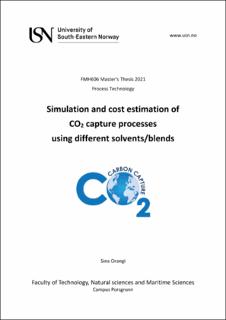| dc.contributor.advisor | Øi, Lars Erik | |
| dc.contributor.author | Orangi, Sina | |
| dc.date.accessioned | 2021-09-08T16:12:19Z | |
| dc.date.available | 2021-09-08T16:12:19Z | |
| dc.date.issued | 2021 | |
| dc.identifier | no.usn:wiseflow:2636125:43485544 | |
| dc.identifier.uri | https://hdl.handle.net/11250/2774682 | |
| dc.description.abstract | There has been a growing trend toward removing CO2 emissions from the industry with different methods. One of
the most mature methods for carbon capture is to absorb CO2 in an amine-based (MEA) post-combustion technology.
Shortcomings of MEA make other solvents and their blends more interesting in CO2 removal plants.
The work in this master thesis is absorption-desorption CO2 capture process simulated in Aspen HYSYS for different
solvents/blends than MEA. Moreover, cost estimation methods for simulated cases have been performed to provide
a complete cost estimation package. The data for cost estimation is provided with Aspen In-Plant Cost Estimator
program.
A base case simulation model consisting of a simplified carbon capture unit including a 10-stage absorber, 6-stage
desorption column, 85% CO2 removal efficiency and minimum approach temperature for the lean/rich heat
exchanger of 10 °C has undergone different solvents/blends of MEA, MDEA and PZ. The results indicate that adding
5 – 10 wt.% of piperazine to base case (30 wt.%) could offer a blend of solvents with lower regeneration energy than
base case. Also, this matter was accurate for adding 5 – 20 wt.% MDEA to base case. Optimization of suggested
range of blends has been performed in term of regeneration energy. Optimized concentrations could be as 30% MEA
+ 5% PZ (wt.%) and 30% MEA + 15% MDEA (wt.%) where lead into 4.9% and 7.5% lower regeneration energy
than base case with 3.77 [MJ/kg CO2]. These blends, also, have been simulated for vapor recompression
configuration. Lean, rich and cyclic loadings for suggested blends in both standard and VR configurations have been
discussed.
Aspen In-Plant Cost Estimator, applying Enhanced Detail Factor (EDF) method, was used for the cost estimation of
processes. based on conducted cost estimations, plant with suggested blends presents cost savings rather than
standard base case. Hopefully, the results in this thesis contribute to perform cost optimization more efficiently. | |
| dc.description.abstract | There has been a growing trend toward removing CO2 emissions from the industry with different methods. One of
the most mature methods for carbon capture is to absorb CO2 in an amine-based (MEA) post-combustion technology.
Shortcomings of MEA make other solvents and their blends more interesting in CO2 removal plants.
The work in this master thesis is absorption-desorption CO2 capture process simulated in Aspen HYSYS for different
solvents/blends than MEA. Moreover, cost estimation methods for simulated cases have been performed to provide
a complete cost estimation package. The data for cost estimation is provided with Aspen In-Plant Cost Estimator
program.
A base case simulation model consisting of a simplified carbon capture unit including a 10-stage absorber, 6-stage
desorption column, 85% CO2 removal efficiency and minimum approach temperature for the lean/rich heat
exchanger of 10 °C has undergone different solvents/blends of MEA, MDEA and PZ. The results indicate that adding
5 – 10 wt.% of piperazine to base case (30 wt.%) could offer a blend of solvents with lower regeneration energy than
base case. Also, this matter was accurate for adding 5 – 20 wt.% MDEA to base case. Optimization of suggested
range of blends has been performed in term of regeneration energy. Optimized concentrations could be as 30% MEA
+ 5% PZ (wt.%) and 30% MEA + 15% MDEA (wt.%) where lead into 4.9% and 7.5% lower regeneration energy
than base case with 3.77 [MJ/kg CO2]. These blends, also, have been simulated for vapor recompression
configuration. Lean, rich and cyclic loadings for suggested blends in both standard and VR configurations have been
discussed.
Aspen In-Plant Cost Estimator, applying Enhanced Detail Factor (EDF) method, was used for the cost estimation of
processes. based on conducted cost estimations, plant with suggested blends presents cost savings rather than
standard base case. Hopefully, the results in this thesis contribute to perform cost optimization more efficiently. | |
| dc.language | eng | |
| dc.publisher | University of South-Eastern Norway | |
| dc.title | Simulation and cost estimation of CO2 capture processes using different solvents/blends | |
| dc.type | Master thesis | |
